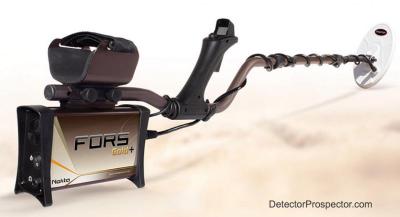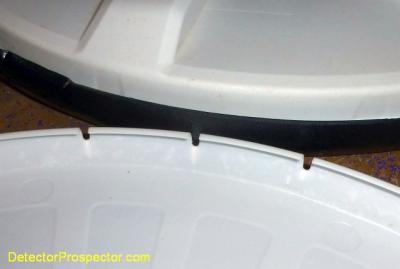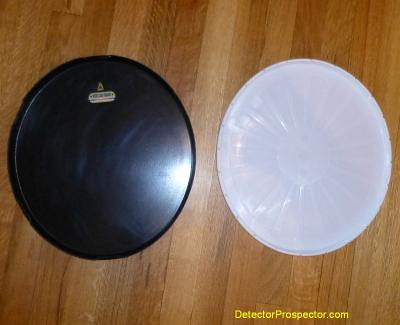-
Posts
19,680 -
Joined
-
Days Won
1,564
Content Type
Forums
Detector Prospector Home
Detector Database
Downloads
Everything posted by Steve Herschbach
-
Yup, andesites and basalts plus moaning/groaning in the alkali. Yet nowhere so far in my experience to be more than an annoyance. The rocks tend to be surface or very shallow (though not always!) and the alkali areas I have done quite well in by just slowing way down. The alkali issue could be solved two ways. One would be to just allow the machine to ground balance fully into the conductive salt range. The downside is just like with any beach detector eliminating the salt signal reduces or even eliminates signals from certain gold targets. But it gives you quiet stable operation in return. A variable motion or SAT control would help also. It is obvious that slowing down allows the GPZ to better keep up with and adjust for the salt signal. Increasing the self adjusting threshold retune rate would allow for faster col movements with less noise. Again, a trade made in faint (small shallow or large deep) target responses being sacrificed. I am taking a bit of a purist approach with the GPZ myself. I know for a fact that eliminating the salt signal and even all hot rock signals takes with it certain gold targets. So long as the number or intensity of such signals does not become truly overwhelming I prefer to just deal with it by digging a few rocks or manipulating the audio responses (in the case of alkali) and retain that edge I feel I have running the machine extremely hot.
-

Fors Gold+ Coming Soon
Steve Herschbach replied to Nokta Detectors's topic in Nokta / Makro Metal Detectors
Doubtful as they are different part numbers. My experience so far with Nokta and Makro detectors is that they sense which coil is on the detector and will not work at all with ones not designed for the machine. I even suspect the machine operating parameters change to accommodate certain coils. -

Fors Gold+ Coming Soon
Steve Herschbach replied to Nokta Detectors's topic in Nokta / Makro Metal Detectors
Marketing. You can't sell VLF detectors by claiming "our detectors find gold about as well as any of the others". VLF tech is old stuff these days with no real change in depth of detection and sensitivity for over twenty years now. There have been a few tweaks on the discrimination side but that's about it. There is more to it than just frequency, but as a rule lower frequency detectors are less sensitive to small targets but have less issues with ground mineralization and hot rocks. Increasing frequency increases sensitivity to tiny stuff while increasing ground issues and sensitivity to hot rocks. Batteries used has no bearing on this issue. There is not much difference between 15 kHz and 19 kHz so I would expect only a minimal boost in small target sensitivity if any. The FORS are unusually hot machines anyway. The change is probably as much for marketing reasons as an actual performance change to better match up specifications with the Gold Bug Pro, the main competition. The new iSAT control does add a new twist as does the change in stock coil. Notice also the option for a concentric coil - a first on the FORS models. Note also the lack of a three tone discrimination mode, replaced by a two tone mode designed for bad ground. Under 10 kHz you have the coin machines. 10 - 20 kHz is the realm of the multi-purpose do everything VLF that is hot on gold. Above 20 kHz would be dedicated units very hot on tiny gold. Multi-frequency acts like the lower frequency range for prospecting purposes. In the 10 - 20 kHz range most popular machines used for prospecting have settled around 14 kHz to 19 kHz. From my perspective at least when comparing for maximum depth and sensitivity they are all about the same. Anyone expecting anything magically different will be disappointed. It is like buying a commuter car. There are bunches of them, all different, but all about the same. They get you from point A to point B. The differences are in the bells and whistles. That all said I very much like what Nokta has done here. Before the differences between the FORS Gold and FORS CoRe were so minimal that they were basically the same detector. See http://www.detectorprospector.com/forum/topic/531-difference-between-nokta-fors-gold-and-fors-core/ for details. The changes make the FORS Gold+ less a multi-purpose detector and more one clearly designed for prospecting. A good move in my opinion. -

New Contest: Can You Recognize Gold?
Steve Herschbach replied to Reno Chris's topic in Detector Prospector Forum
Heck, just take the best previous answer and change whatever looks wrong! -

Fors Gold+ Coming Soon
Steve Herschbach replied to Nokta Detectors's topic in Nokta / Makro Metal Detectors
I like that this makes the FORS Gold a different machine in in own right. Before it was too similar to the FORS CoRe. I would keep the CoRe as is and replace the old FORS Gold with this model. -
I don't think direct equivalence in the gain can be determined except in the loosest way. They are different detectors and what happens at different gain settings varies dramatically depending on the nature of the gold used as a test target. The Smoothing off equals Stabilizer at 20 thing is mentioned by JP at http://www.minelab.com/usa/treasure-talk/using-the-gpz-7000-in-high-emi-conditions-and-audio-smoothing
-

Your Government Employees At Work
Steve Herschbach replied to Clay Diggins's topic in Detector Prospector Forum
I actually have dealt with many, many folks in government agencies. Nearly all my experiences have been positive. There are a few bad apples in every barrel, but most people in government I have dealt with are just decent people trying to do a good job. I do think asking for help up front and a thank you when I am done have got me a lot farther than having a chip on my shoulder. There is also no substitute for knowing the rules and firmly standing my ground when I have to. Good post Clay - thanks! -

More New Generation Coil Questions Than Answers
Steve Herschbach replied to jasong's topic in Minelab Metal Detectors
I think that with rare exceptions stock factory coils are better than most people give them credit. The manufacturer is trying hard to optimize the machine for the task and cutting corners on the coil just makes no sense. Real effort goes into making coils that match the machine well for best performance. If I am biased at all it tends to be in favor of OEM coils. On the flip side I am thankful for the aftermarket folks providing optional sizes and shapes the manufacturers never bother to build. -

More New Generation Coil Questions Than Answers
Steve Herschbach replied to jasong's topic in Minelab Metal Detectors
Just call me a skeptic when it comes to coils and the never ending parade of "new improved with super duper wire" or other marketing claims. I watched at Moore Creek while with first the GP series and then the GPX series while every year like clockwork a new super duper coil became the rage. Lots of people showed up with the coil of the year. Then the next year it was a new super duper coil, and last years winding wonder was forgotten. I am not singling any particular company or coil out but in general I think it is marketing bs. For me it boils down to DD or mono, the general size and shape I desire for my given task, combined with weight and build quality. I don't believe any coil will turn a GPX into a GPZ. There is that little matter of the electronics in the box and what it does. -

Detectorpro "Nugget Buster" NDT's
Steve Herschbach replied to beardog's topic in White's Metal Detectors
The Nugget Buster NDT (no down time) comes with two cables. One to use and one to replace it with if it breaks. You should not cave to buy another unless you broke both of those. I never did break my first one. -

My Nugget Detecting Kit
Steve Herschbach replied to Steve Herschbach's topic in Metal Detector Advice & Comparisons
The intent was more about detecting accessories more than anything else. The Hipstick is a great addition for many people to consider. In transferring the weight from shoulder to waist it can be s real fix for sore shoulders and arms. -
You may have got a coil that had been sitting on a shelf for a spell. It is a known problem with the early coils. My understanding is that the latest coils have been improved. Since it is a DD coil it cannot be made in an open design but something stouter and less buoyant like the Fisher coil of similar size could have been done. The coil originated as a Makro design and then crossed over to Nokta and so does not really fit in with what Nokta owners are used to seeing.
-

My Nugget Detecting Kit
Steve Herschbach replied to Steve Herschbach's topic in Metal Detector Advice & Comparisons
I am sure some of us are more equipped than others to live off the land beardog. I guess it all depends on the situation you are anticipating. In my case I am never more than a few miles from my vehicle. The only scenario that makes sense to me is that I have hurt myself badly enough I can't get back to my rig. A bad fall perhaps? In which case my goal is not to live off the land, but to be rescued immediately. Therefore the two way satellite communication device. Or I am in middle of nowhere, out of cell phone range, vehicle breaks down. Again, communications is the key. -

My Nugget Detecting Kit
Steve Herschbach replied to Steve Herschbach's topic in Metal Detector Advice & Comparisons
It weighs so little it makes no difference to me physically whether the scale is in my pack or not. And sometimes I just want to know what that big chunk weighs then and there. So I guess it is instant gratification! -
My understanding is that it is not a case of more is better but that the ohms should match the instrument.
-

Finally - Forum Calendar Activated
Steve Herschbach replied to Steve Herschbach's topic in Meet & Greet
Why thank you very much! Kind of you to say so and nice to hear. I have always enjoyed working on websites so it keeps me occupied when not prospecting. And Chris - he is a walking mining encyclopedia! -
What don't you like about it Scott?
-
OK, I had a spare Minelab skid plate and Miner John was kind enough to send me one of his. And just so people know the one Doc sells is made by Miner John - Doc just slaps his own sticker on them. It is fairly simple. Almost all scuff covers are made of the same fairly stout plastic. For some reason on the SDC 2300 and GPZ 7000 Minelab has gone to a soft plastic (polypropylene?) which is about the same stuff as makes up an old style coffee can lid. It is flexible and soft and wears quickly. The Miner John seems barely any thicker but it is the standard skid plate material we are all used to. Quite stout and will barely flex at all. There is extra material there however. The Minelab cover weighs 4.3 ounces while the Miner John cover weighs 7.4 ounces. The Minelab brand cover must be aligned perfectly to get on but goes on easy enough. However, if you look at the picture below closely you can see stress marks at each notch where the plastic stretched and in a couple spots looked close to splitting just putting it on. The Miner John version went on easy enough until the last notch. I just pushed a bit harder and it popped on, no tools needed, but some may want to use a screwdriver or butter knife to ease that last notch over the edge of the coil. The Miner John is about 1/4" to 3/8" higher that the Minelab version. No doubt a bit of the extra weight creeps in here. This is also good in that it protects the sides of the coil better, but bad in that it creates a channel around the edge to collect fine silt, which can then work down into the space between cover and coil. I doubt it will be much of an issue however and I honestly never had much problem in that regard with the Minelab cover either. My personal take given that both these covers cost about the same in the United States is that the Miner John is the far better buy. It is bound to last much longer, easily twice as long or more I am guessing. The Minelab cover does weigh less and if you keep the coil suspended over the ground that might matter. But then you really do not need a heavy duty scuff cover anyway. Mine rides on the ground so the extra weight won't matter. For somebody really using the GPZ a lot it will add up in savings over time. We will see. I will use the Miner John and keep the Minelab cover for backup.
-

Forum Member Profile Information Tweak
Steve Herschbach replied to Steve Herschbach's topic in Meet & Greet
Freshly dug Australian nugget. Photo by Jonathan Porter. Can't get much better than that! -
If you go to your name in the upper right next to "Sign Out" and select "My Settings" by clicking on your name, you can adjust your basic forum settings and information. Be sure and set your time zone! If you put something in the Location box it displays in your posts under your avatar/picture. In the past the Interests box only showed if people looked at your profile. I have made that also display under the avatar/picture. See my examples to the left. I also added a new field "Gear Used" where you can list your favorite detectors, dredge, ATV, whatever. This also will end up displaying under the avatar/picture. All this stuff is totally optional and honor system obviously. In the left column is the "Signature" option which is where people create those signature lines you see under all their posts. You can get pretty creative there as an alternative to these simple options. Any comments of other suggestions please let me know.
-
People often confuse the abilities of prospecting metal detectors with the abilities of the prospectors running them. Human nature I guess. Do golf clubs make the golfer or is it the other way around? There is no one metal detector best for all people, all places, and all budgets. We all have to decide what will work best for us given our circumstances. I certainly wish the best of luck to anyone using whatever they have. The best weapon in your arsenal is knowledge and hopefully this forum helps add to that most important of prospecting tools.
-
Nice charts Jason, thanks! It is just a brief incomplete snapshot. That is why I lumped similar models together. I don't think it much matters if it is a GP3000 or a GP3500. Obviously there are machines not listed that are getting used. There are people using AT Golds and MXTs and Eureka Golds and finding gold in the last year. I have said repeatedly don't read too much into it. But I do think the very broad picture is represented halfway accurately. Lots of people using GPX detectors for sure. Lots of Gold Bugs for sure. Most people have moved on from the SD models for sure. And so on. One problem doing this again would be people trying to stuff the ballot box for various reasons. This was quick and caught people off guard so no time to try and manipulate it much.





